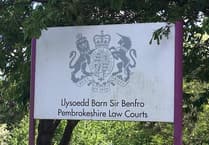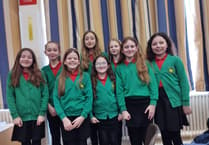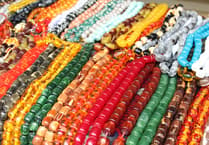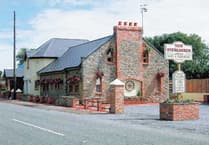On his return to Pembroke, he gave art classes. The murals grew out of that, and can be seen in various locations, including a sports hall back in Surrey. At first he considered hanging paintings by his students in the hallways of Pembroke Town Hall, but on discussion with Phil Lloyd, the town clerk, a mural was decided on. The Mabinogion was the first subject considered, but then the history of Pembroke was chosen.
The mural (n.b. not Muriel!) was created on eight-foot by four-foot 9mm MDF panels. These were given four coats of matt emulsion. The cartoon, which had been drawn previously for each panel after copious amounts of research, including at the National Library in Aberystwyth, was transferred to the panels, by squaring of the cartoon and the panel, and transferring by hand. A colour plan for each panel was also made, and the colours were mixed in 300 jam jars from white emulsion paint and acrylics.
When Mr Lewis had a new garage built, he made sure it was 10-foot high so he could work standing up doing the panels. His wife, Jeanne, also an art teacher, did a lot of the colouring. They outlined the paintings with a darkish brown colour, using the thickness of the line and mock shadows to show depth rather than modelling. One panel took at least a full day, usually considerably longer. Each panel has five coats of varnish to protect it.
The panels show the history of Pembroke from 300 BC to 1911. Each panel has a self-portrait on it, a Where's Georgie, rather than Where's Wally.
Mr. Lewis told in more detail about the panels from the initial one of the Stone Age, up to the one depicting medieval times when Owain Glyndwr was bribed to leave Pembroke Castle alone during his wars with the English.
The first panel, titled Before the Normans, shows flint tools being used - and as there is no flint in Pembrokeshire, it had been imported from Derbyshire! The Romans only made it to Carmarthen, but there are records of them in Pembroke. Also shown is St. Deiniol, who lived as a hermit in Pembrokeshire before going to Bangor to become Bishop, and Hubba the Viking, who gave us Hubberston.
The next panel, The Coming of the Normans, shows part of the Bayeux Tapestry, De Valence (an earl of Pembroke), and Nest (the mistress of King Henry). As there are no images of Nest, her face was based on the painting, The Lady of Shallot! Monkton Priory which was founded in 1162 is shown, and Henry and Strongbow leaving for their invasion of Ireland.
Members had to leave the rest of the mural waiting, as the refreshments were beckoning!



